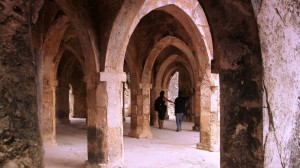by Peter Elborn
The Cessna landed on Kilwa’s grass airstrip, where two men were sitting in the deep shade of a big tree. There was no one else around. I stopped to talk to them. I knew I could walk to Kilwa Ruins Lodge, where I was going to stay for four nights; but – as they said – it would be hot work pulling a trolley case along a sandy road. One of the men had a car in the shade of another tree, and he took me on the short, bumpy ride to the Lodge.
Kilwa Kisiwani is an island just off the coast from the fishing village of Kilwa Masoko. Historically it was the southern point for sailing vessels going down the East African coast using the monsoon winds. They came to trade – most importantly gold and ivory from inland Africa. From the 11th to the 15th century Kilwa was a city-state with fine mosques and grand palaces. In their time, the Great Mosque was the largest mosque in Africa and Husuni Kubwa, the Great Palace, was the largest stone structure in sub-Saharan Africa. Kilwa had its ups and downs until the 19th century, when the slave trade ceased and it became a backwater. This once prosperous city-state fell into ruins.
The only guy around at the Lodge had no knowledge that I was coming, but cheerfully gave me a key to a thatched wooden hut. I was asked what I wanted for lunch. I thought it best to ask what they had. The reply, after some thought, and with some hesitation, was – fish. So I said fish would be very nice.
The next day I ambled around the town in search of the Antiquities Department to get the required permit to visit Kilwa Kisiwani, called ‘the ruins’ locally. Kilwa Masoko is a small place and I had expected to find the Antiquities Department by ambling. But I didn’t.
After lunch and an hour in the shade with a book, I guessed that I might find someone to talk to about getting to the ruins at the harbour, from where the dhows cross to Kilwa Kisiwani. There was not much there, other than an empty jetty and a few men under the shade of trees. One of them called over a young guy who had a dhow and could take me the next day. But today we would need to get the permit. We found the Antiquities Department in a compound behind a gate with a sign saying “Revenue Department”. After 10 or 15 minutes my name was entered in a ledger (including my passport number, but as I did not have my passport with me or any idea what the number was, I made it up). I paid a fee and that was that – a good day’s work.
As no one was around at the Lodge early next morning, I breakfasted on a honey crunch bar left over from the flight from London and walked to the harbour. There was a port fee, requiring another entry in a ledger, with another invented passport number. No boatman from the day before, so the man who had been helpful shouted to three people on a dhow, who agreed to take us. We waded out, climbed aboard and a patched triangular sail was hoisted. A gentle half hour later we got close enough to the island to jump over the side and slosh our way ashore.
A half an hour walk along the edge of a mangrove swamp brought us to the Husuni Kubwa perched on a low cliff by the sea. All very grand in its time, but now just enough left to see that it had indeed been a great palace. We weaved our way along sandy paths through lush tropical vegetation back to the main site, passing neat and tidy mud huts with people quietly drawing water from an ancient well.
The Great Mosque – 11th century in origin, and enlarged in the 14th century with money from the gold trade – is still impressive. Other smaller mosques are scattered around, as well as later buildings, including the fort built by the Portuguese during their short stay at the beginning of the 16th century. After they left the fort was enlarged, falling into disuse in the late 19th century.
Returning to the mainland we had to tack against a strong wind. The sail filled, the boat keeled over and waves flooded into the boat. One of the boatmen calmly bailed.
Over the next two days I explored Kilwa Masoko and adapted to the heat, humidity and the slow pace of life. I swam when the sun was low and less fierce, read in the shade, and enjoyed walking around the town and the market. And then it was time for a last stroll by the sea and a return to the airstrip. As we waited for the plane I watched the little ants crawl over my suitcase.
Two international aid workers arrived in a smart 4-wheel drive vehicle bearing the logo of a water project and talked on their mobile phones. Accompanying them were two Tanzanians. She was well-groomed in a tailored African print dress with puff sleeves. He wore a smart dark blue safari suit. They talked with confidence.
Then the plane arrived and I was off, back to Dar and on to London.
Thank you Jennifer Glentworth for putting us in touch with Peter – Editor
Peter Elborn spent four months in Dar es Salaam in 1991 and visited frequently from 2000 to 2004 when he was the British Council Regional Director East and Central Africa, based in Nairobi. However, it was only after retirement that he was able to get to Kilwa.

